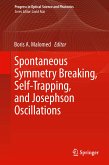Expanding upon the ideas first proposed in his seminal book Cosmical Magnetic Fields, Eugene N. Parker here offers the first in-depth treatment of the magnetohydrodynamic theory of spontaneous magnetic discontinuities. In detailing his theory of the spontaneous formation of tangential discontinuities (current sheets) in a magnetic field embedded in highly conducting plasma, Parker shows how it can be used to explain the activity of the external magnetic fields of planets, stars, interstellar gas clouds, and galaxies, as well as the magnetic fields in laboratory plasmas. Provocative and fascinating, Spontaneous Current Sheets in Magnetic Fields presents a bold new theory that will excite interest and discussion throughout the space physics community.
Dieser Download kann aus rechtlichen Gründen nur mit Rechnungsadresse in A, B, BG, CY, CZ, D, DK, EW, E, FIN, F, GR, HR, H, IRL, I, LT, L, LR, M, NL, PL, P, R, S, SLO, SK ausgeliefert werden.


